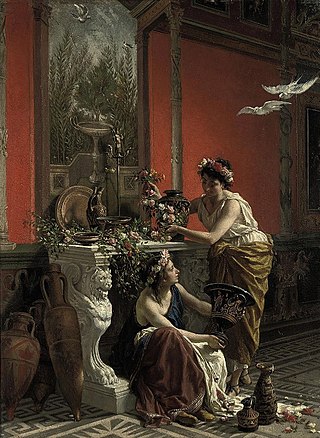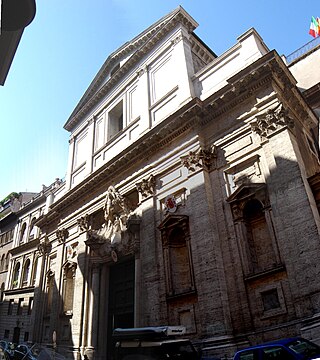Related Research Articles

Giovanni Lanfranco was an Italian Baroque painter.

San Francesco a Ripa is a church in Rome, Italy. It is dedicated to Francis of Assisi who once stayed at the adjacent convent. The term Ripa refers to the nearby riverbank of the Tiber.

Camillo Procaccini was an Italian painter. He has been posthumously referred to as the Vasari of Lombardy, for his prolific Mannerist fresco decoration.

Santa Maria in Campitelli or Santa Maria in Portico is a church dedicated to the Virgin Mary on the narrow Piazza di Campitelli in Rione Sant'Angelo, Rome, Italy. The church is served by the Clerics Regular of the Mother of God.
Luigi Fontana was an Italian sculptor, painter and architect.

Santi Venanzio e Ansovino was a Roman Catholic church situated near the Capitoline Hill in Rome, in the area now occupied by the Piazza d'Aracoeli. It was dedicated to two saints associated with the city of Camerino: Venantius of Camerino, a martyr; and Ansovinus, bishop of Camerino. The church was also called SS Venanzio ed Ansovino de' Camerinesi.

San Nicola da Tolentino agli Orti Sallustiani is a church in Rome. It is referred to in both Melchiori's and Venuti's guides as San Niccolò di Tolentino, and in the latter it adds the suffix a Capo le Case. It is one of the two Roman national churches of Armenia. The church was built for the Discalced Augustinians in 1599, and originally dedicated to the 13th century Augustinian friar Saint Nicholas of Tolentino.

Cesare Mariani was an Italian painter and architect of the late-19th century, active in Rome and Ascoli Piceno.

Giuseppe Nicola Nasini was an Italian painter of the Baroque period and active in Rome and Tuscany.

The Spanish National Church of Santiago and Montserrat, known as Church of Holy Mary in Monserrat of the Spaniards is a Roman Catholic titulus church and National Church in Rome of Spain, dedicated to the Virgin of Montserrat. It is located in the Rione Regola, at the intersection of alleyway of Via della Barchetta and the narrow Via di Monserrato, with the facade on the latter street, about three blocks northwest of the Palazzo Farnese.

Giovanni Giacomo Barbelli was an Italian painter of the Baroque period, active in Lombardy. He was a canvas and fresco painter known for his religious and mythological scenes that decorated many churches and residences in Lombardy. He was a highly skilled draughtsman and a brilliant colorist. His work shows an inventive imagination and a thorough knowledge of perspective.

Camilla Battista da Varano OSCl,, from Camerino, Italy, was an Italian princess and a Poor Clare nun and abbess. She is venerated as a saint in the Catholic Church.

Nicola Consoni (1814–1884) was an Italian painter, mainly of sacred and historic subjects.

Giuseppe Galeòtti (1708-1778) was an Italian painter, active in a Baroque style, mainly in Liguria.

Santa Maria delle Grazie is a Baroque-style, Roman Catholic basilica church located in the town of Este in the province of Padova, region of Veneto, Italy. Within the shrine is the image of the Blessed Virgin Mary of Graces, transferred from the ransack of Constantinople and ultimately crowned by Pope Pius VII in 10 December 1822.
Paolo Gamba was an Italian painter of the late Baroque period, active in the region of Molise.
Santa Maria in Via is a Baroque style Roman Catholic church and Marian Shrine in Camerino, in the province of Macerata, region of Marche, Italy.
Santa Chiara is a Roman Catholic church and monastery in the town of Camerino, province of Macerata, region of the Marche, Italy. It is located just outside the old city walls, and is best known for housing for during the late 15th and early 16th centuries, the Clarissan nun, Saint Camilla Battista da Varano.

Venanzio da Camerino was an Italian painter of the Renaissance period.

Cingoli Cathedral is a Baroque Roman Catholic cathedral dedicated to the Assumption of the Virgin Mary in the town of Cingoli, province of Macerata, region of Marche, Italy. It stands on the central piazza opposite the town hall.
References
- ↑ Biografico degli Italiani - Volume 79; (2013); by Francesco Franco.
- ↑ Istituto Matteucci biography.
- ↑ Enciclopedia Treccani.
- ↑ Camilla Battista da Varano was beatified in 2010, her painting is now in the Museum of the Church of Santa Chiara in Camerino.
- ↑ Dizionario degli Artisti Italiani Viventi: pittori, scultori, e Architetti, by Angelo de Gubernatis. Tipe dei Successori Le Monnier, 1889, page 337.
- ↑ Enciclopedia Treccani.
- ↑ This church is distinct from the better known church of Santa Maria in Via in Rome.
- ↑ Notice of works in Santa Maria in Via in Corriere Proposte.
- ↑ Province of Macerata Tourism site, entry on church of Santa Maria in Via.
- ↑ Enciclopedia Treccani.